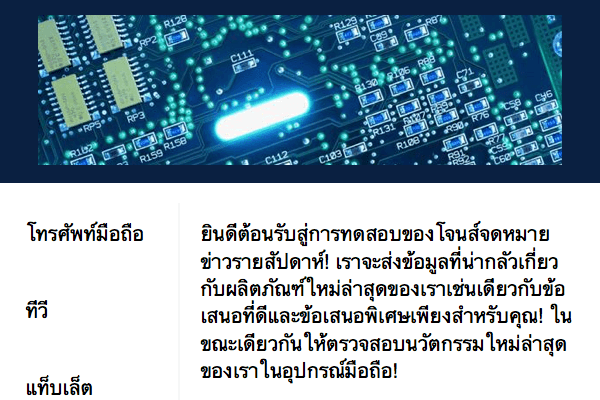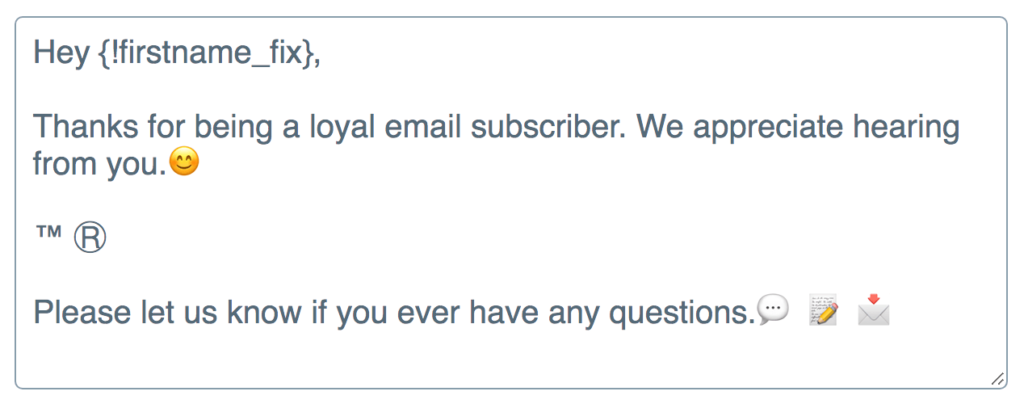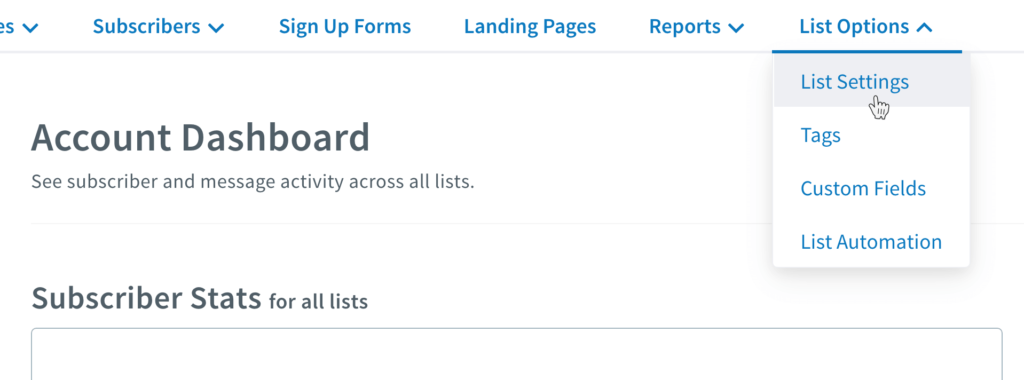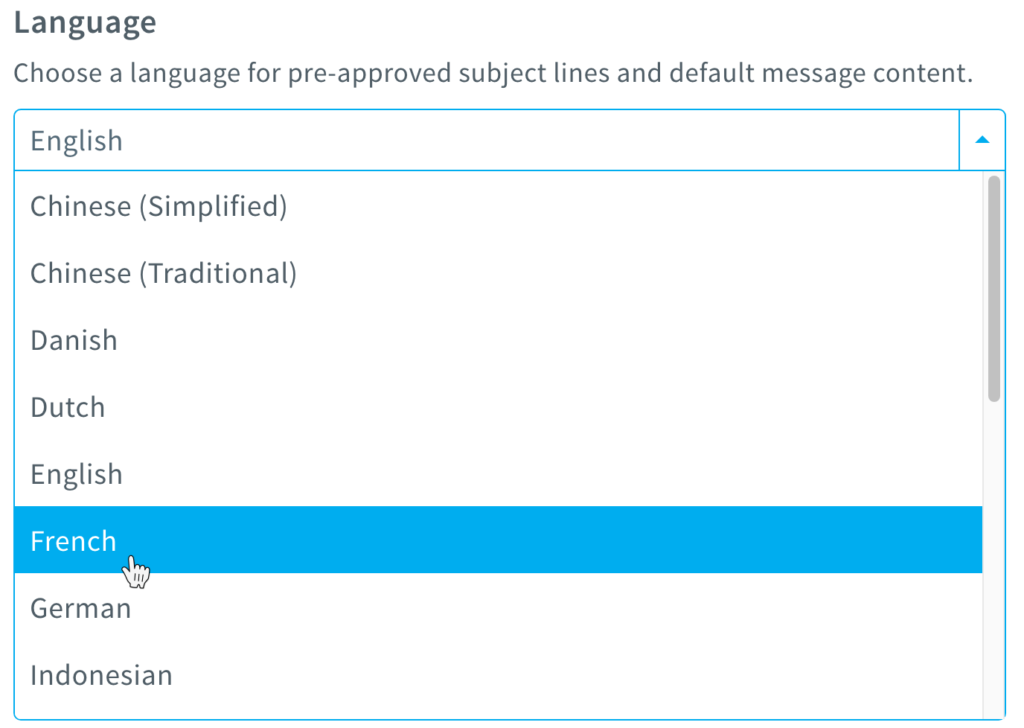Sending Emails Your Customers Want… In Another Language
By Kristin MacLaughlin August 12, 2020
Hello! Or should I say, Hola! Bonjour! Konnichiwa!
Email is global. As you set out to grow and engage your audience through email marketing, there’s no geographic limit to where someone could discover you and join your list.
Creating emails brimming with compelling content and engaging visuals is essential to a successful email marketing campaign. But what happens when the person reading your emails doesn’t speak the same language as you?
Easily translate your emails into any language with Unicode
Unicode is an international encoding standard that allows emails to be delivered to subscribers in different languages. The Unicode characters will allow your subscribers to read your content in their native language.
When you write emails using Unicode characters, it becomes a lot easier to create messages that your customers and prospects can understand.
If you have a subscriber that speaks a different language (such as Thai), they will be able to see Thai characters (such as ณ) in your message.
Example of a message in Thai

If writing messages in a foreign language isn’t a concern for you, you may want to use Unicode to add symbols ( $↞ ) and emoticons (😻 🌞) to jazz up your messages. Because who doesn’t love a cat with strange heart eyes and smiling sun?
Examples of using symbols and emoticons

Taking the time to send emails in your subscribers’ native language(s) shows that you value them.
Not only does this mean you can more clearly connect and communicate with your audience (or even reach new audiences), you’ve given your subscribers a reason to trust you more than ever before.
That makes growing your email list and developing long-lasting relationships with your customers easy.
Breaking the language barrier
AWeber enables customers to send emails to their email marketing lists in any language using Unicode.
Here are four ways you can use foreign characters to better connect with your subscribers:
1. Send segmented messages

If you have subscribers from various countries, you can make it easier for them to read your emails by sending targeted emails in their native language(s). When they can read your message in their native language, it’ll help create a more positive experience for your customers and prospects.
Removing language barriers between you and your subscribers also eliminates the possibility of miscommunication. Instead of leaving it up to your subscribers to translate your message, they’re able to understand you immediately.
And when your audience has a clear understanding of the value your products/services will bring to them, they’ll be in a better position to make a purchase.
Pro Tip: Add international keyboards (if you haven’t already) to your computer to easily create new email messages in different languages.
2. Personalize your bilingual emails

It’s frustrating when you want to send a personalized email to your subscribers, only to discover that a character in their name isn’t supported and, consequently, doesn’t display correctly. And if you can’t do this for every single subscriber, it becomes difficult to do it at all.
Fortunately, AWeber sign up forms use UTF-8 (the character encoding system that stores and displays Unicode characters correctly).
AWeber sign up forms accept Unicode characters, which allows your subscribers to enter characters in their native language. So if you have a subscriber that speaks a different language (such as Thai), they will be able to enter their information in your form using characters (such as ณ) from that language.
Pro Tip: Add “First Name” custom fields to your subject lines and/or within your email messages to grab your subscribers’ attention and create a more individualized experience.
3. Send Confirmation Opt-In messages in 19 different languages
Already know that your target audience primarily speaks a specific language? By greeting your subscribers in their own language, you can increase the conversion rate of confirmations and kick off a lasting relationship with your new prospects and customers.
Confirmed opt-in is one of the best ways to protect your list against unwarranted SPAM complaints, malicious sign ups, and it helps to keep the unsubscribe rate low.
If you know your audience will prefer a specific language, select that language to provide more clarity on how they can confirm their email address. By greeting your subscribers in their own language, you can increase the conversion rate of confirmations and kick off a lasting relationship with your new prospects and customers.
These are the language options that are currently available:
- Chinese (Simplified)
- Chinese (Traditional)
- Danish
- Dutch
- English
- French
- German
- Indonesian
- Italian
- Japanese
- Korean
- Malay
- Norwegian
- Polish
- Portuguese
- Russian
- Slovenian
- Spanish
- Swedish
How to easily change your language selection
To change the confirmation message language for an active list, select List Settings in the List Options dropdown of your account.

Choose Confirmation Message on the left-hand menu, and in the Language section, select the language that meets your needs.

Example of French language confirmation message

When you select a language, the header, body, and signature of the confirmation message will automatically update.
All approved subject lines will be translated. If you are using a custom one, you will need to translate it directly.
Pro Tip: If you’re not sure what language your subscribers prefer, consider surveying them.
4. Send international emails in two or more languages.
You can create a separate email in each language or you can use dynamic content. Dynamic content changes based on the viewer’s criteria. Often most people only use dynamic content to personalize a greeting. By adding a personalization snippet after the greeting like — ‘Hello {{subscriber.first_name}}’
But you can use dynamic content for multi-language campaigns, if you know your individual subscriber’s preferred language or their IP address.
Set up dynamic content for different languages
Let’s say that you have an email campaign, and you know your subscribers’ native language is either English, French, or Spanish. You could create three emails in each of those native languages. Or use dynamic content to create just one email, making the content in your email dynamic, so each recipient receives an email in his or her own native language.
You will need to segment your list by assigning tags to identify the subscriber’s native language. Get this information by asking them their preference with an AWeber landing page, sign up form, or a survey.
Pro Tip: Where there are cases in which you cannot identify a recipient’s country/language, he or she will receive the email in English by default.
To make this process easier, AWeber automatically lists the location where the subscriber signed up. For example, if the subscriber lives in a known Spanish-speaking country, you could assign a Spanish tag since that is the native language.
How to use dynamic content for native languages
Dynamic content is a combination of a default version of the text and variants for every other language that you support.
Not fluent in the language you want to send? Put your copy into Google translate to receive a language translation.
One word of warning: Google Translate is not always perfect. It is a decent option if you are not fluent or don’t have the resources to hire a translator.
Once you have the translation, then you simply add some conditional content language for each text section. Just make sure your have a language tag assigned to your subscribers.
If your subscriber has the language tag “fr” the french version would appear. If their language tag is “es” the spanish version would appear.
Here’s how you would write the dynamic logic markup would look like to add conditional content in the greeting.
{% if “fr” in subscriber.tags %}
Bonjour…
{% elif “es” in subscriber.tags %}
Hola…
{% else %}
Hello…
{% endif %}
You would repeat the process above for each text section. If you interested in learning more about adding dynamic logic into your emails, AWeber has step-by-step guides on how to add conditional content logic markup.
“I can’t think of a nicer gesture than making sure each of your subscribers receives your email written in their own native language,” says Email Delivery Product Manager Dave Stys.
Tips for sending emails in the most common languages we see in AWeber
3 tips for sending emails in French
In France, there is more formality when addressing others than in the United States. While you can always send the same translated content to your French-speaking subscribers, you may want to make a few minor adjustments.
- Use the proper greeting and close. If you collect your subscriber’s first and last name, consider taking an extra step to send a greeting using their last name versus first name. Include the appropriate prefixes: Mr., Mrs., and Miss. Note: There is no French equivalent for the prefix Ms. and in 2012 the France Prime Minister banned the use of Mademoiselle in legal documents, so Mademoiselle is less frequently used.
- Write a concise, and descriptive subject line. When you test subject lines, you will most likely find a shorter, concise, and descriptive subject line has a higher open rate for your French readers.
- Structure your email with clear sentences that identify the value. Your french readers will be receptive to sentences that clearly outline the value and the benefits. Keep in mind that the value can take a variety of forms: financial (free delivery, a coupon for a discount), convenience (auto-shipments, electronic receipts, track shipment notices), or information (recipes, free additional content, how-to tutorial).
3 tips for sending emails in Spanish
You may not want to limit sending Spanish emails just outside of the United States. If you have an extensive subscriber base in California, Texas, and Florida, it may be worthwhile surveying your customers on how many speak Spanish since these three states include 57% of Spanish-speaking Latinos in the U.S.
If you have a large number of subscribers who speak Spanish, you may want to identify your Spanish speakers and give them the option to receive your content in English or Spanish. There are 57 million Latinos in the United States, and the U.S. Hispanic population is expected to grow to one-quarter of the total U.S. population by 2050.
- Consider an alternate content presentation. The Spanish language has a more persuasive style and argument structure, so consider altering how you typically deliver content if you create a Spanish version. To get your point across, lead with the emotion and the why of your product versus an analytical approach.
- Know your audience’s market and how Spanish is used. There is no “typical” Hispanic customer, so try to learn as much about your audience as possible, like education, country of origin, and geographic location. A Pew study identified that Spanish-speaking markets vary drastically on a city-by-city basis. For example, 90 percent of Latinos speak Spanish at home in Miami, FL, and McAllen, TX. Other major markets with Spanish-speaking populations of 79 percent or above include El Paso, Los Angeles, New York, Atlanta, Dallas, and Orlando.
- Simply translating English to Spanish may not be enough. Most Hispanic marketing experts have found that translating content from English to Spanish alone is not enough to have an effective campaign. You may want to invest in a copywriter fluent in Spanish and familiar with the Spanish culture to guide you on cultural references and nuances. But it may be well worth the effort, a “Facebook IQ” study conducted by Latinum Network found:
- When online, more than 80% of Spanish-dominant Hispanics use Spanish at least half of the time when they read, write, or watch videos.
- 79% of Spanish-dominant, 82% of bilingual, and 60% of English-dominant Hispanics surveyed think brands should reach out to consumers in both English and Spanish.
- 58% of Spanish-dominant Hispanics and 48% of bilingual Hispanics believe that brands that reach out in Spanish demonstrate they value the Hispanic community.
A note before you send
You can’t copy and paste foreign characters from an outside service like Microsoft Word. Your content must be created within the email to guarantee language support.
Getting started
Sending emails to subscribers in their native languages is a simple way to improve the communication between you and your customers and create an enjoyable brand experience.
If you have any questions about sending international emails, don’t hesitate to reach out to our award-winning customer solutions team.
Best free email marketing software
Our mission is simple: to deliver powerfully-simple email marketing tools to help small business owners and entrepreneurs — like you — grow your business.
AWeber Free is our completely free email marketing and landing pages plan — perfect for those who are just getting started or kicking off a passion project. We’ll give you everything you need to start building your audience today.
 87% off ends soon!
87% off ends soon! 
